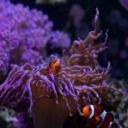Yahoo Answers is shutting down on May 4th, 2021 (Eastern Time) and beginning April 20th, 2021 (Eastern Time) the Yahoo Answers website will be in read-only mode. There will be no changes to other Yahoo properties or services, or your Yahoo account. You can find more information about the Yahoo Answers shutdown and how to download your data on this help page.
Trending News
how do frogspawn coral reproduce other than head splitting?
I've seen torch coral babies on the shelf at the LFS. These were tiny torches where the torches being sold had been placed. They were not even big enough to have a skeleton. how does this happen?
My frogspawn has a green spot about 2mm wide that looks like a tine frog is coming out of it or something. I've really no idea what this is. It could just be a blimish on my coral. In what ways do frogs reproduce other than splitting? This frog has just recently split.
Frogspawn pic... http://img228.imageshack.us/img228/9677/frogger1.j...
4 Answers
- Kay BLv 41 decade agoFavorite Answer
Your frogspawn is budding which is another form of coral reproduction. There also appears to be more on the way that haven't yet erupted from the coral's tissue.
My frogspawn has dozens of those and they all become independent frogspawn polyps, though share the same skeleton. The tissue at the base of the rock can encrust onto the rock as well and budding can occur from there as well.
Photo of mine with larger bud-lings (I turned on the lights at night to take this photo because during the day the larger heads obscure these smaller ones)
Source(s): My frogspawn has done the same thing. Between head-splitting and polyp budding it has gone from a tiny single-headed frag to a huge 40+ headed frogspawn colonly. - MarbieLv 51 decade ago
That picture looks like your coral is producing a new head, but it's hard to tell.
Believe it or not, corals do produce both sexually and asexually. We usually see asexual reproduction in captivity, but in the wild corals produce sperm and eggs that, when joined (fertilized eggs) produce a small larvae that swims in the water column and will eventually settle into a new coral. However, larvae are very prone to predation so only a few out of thousands survive to settlement.
Even newly settled corals produce skeletons though, it probably just wasn't visible. If it was a young torch, the owners of your LFS were either lucky enough to both have a coral reproduce and raise the larvae (very hard to do!) or the young one was shipped from them, or it might have been a small head that was fragged and the tissue made it seem like there was no skeleton.



